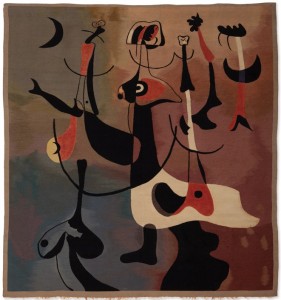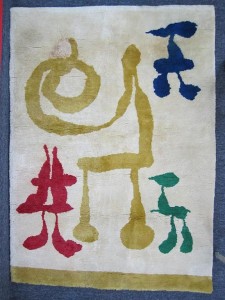
Joan Miró, Tapestry by Marie Cuttoli “Personnages Rythmiques,” 1934
Sold for 170,000 Euros at Auctionata 29 Nov 2013
Joan Miró (Catalan, 1893- 1983), the renowned Surrealist artist, became enamored with the medium of tapestries in the 1920s. Marie Cuttoli, the wife of a French senator from Algeria, hoping to revive the fading ateliers of Aubusson by creating tapestries to be sold in her fashionable Parisian shop, solicited paintings from her artist friends including Picasso, Braque, Matisse, Leger, Dufy and others. Only Miró delivered full-sized “cartoons for tapestry” which Cuttoli then had woven in editions of one or two.
Exhibited in the United States in the 1930s alongside the paintings that inspired them, Cuttoli’s tapestries initially didn’t sell well — collectors, stung by the Depression, preferred the less expensive paintings, which ironically are vastly more valuable today.
The American tour was promoted by one of Cuttoli’s best clients and her tireless supporter, the visionary collector Dr. Albert C. Barnes.
Several Cuttoli tapestries from this era are still on display at the world-famous Barnes Foundation in Philadelphia.
One of Miro‘s original “tapestry cartoons” hung in Cuttoli’s Paris apartment for many years until it was purchased by Nelson Rockefeller. In the 1970s a new tapestry version of this “cartoon” was woven by the state-owned atelier, the Gobelins, which was established by Louis XIV in the 17th century. The painting itself is part of the part permanent collection of the Museum of Modern Art in New York. Another “cartoon for tapestry” painting belongs to the Art Institute of Chicago. In 2007 this painting was exhibited alongside the tapestry it inspired in a show on Surrealism that began at the Victoria and Albert Museum in London and toured other museums.
In the 1950s Cuttoli switched her attention to less expensive pile rugs and Miro allowed numerous of his designs to be recreated in larger editions. Though they are smaller and less expensive than flat-woven Aubussons, these “tapis” as they are called in French — which are often mis-identified as tapestries because they hang on the wall– remain very popular and are considerably less expensive and easier to find. For many years copies of these tapis belonging to the Bronfman family hung in the lobby of the Four Seasons Restaurant in New York’s iconic Seagram’s Building.
There were also at least two Miro designs translated in tapestry by the Pinton Atelier in the 1970s — “Night Creature” and “Composition Verticale (L’Enrage).” Like most Pinton tapestries, these were made in the standard editions of 6 with two authorized artist proofs.
While they are often called tapestries, the monumental Mirós textiles that hang in places like the National Gallery of Art in Washington, D.C., Barcelona’s Miró Museum, and the destroyed World Trade Center are not tapestries like the ones woven in Aubusson, but rather fabric sculptures woven by contemporary Spanish artist Josep Royo.

